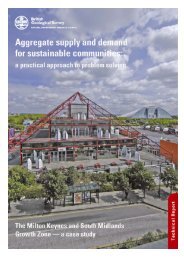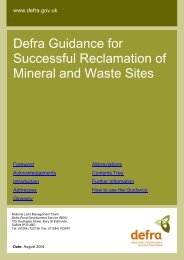creating environmental improvements through biodiversity
creating environmental improvements through biodiversity
creating environmental improvements through biodiversity
Create successful ePaper yourself
Turn your PDF publications into a flip-book with our unique Google optimized e-Paper software.
In addition to providing economic benefits, this project has demonstrated the value of the rehabilitation<br />
process in enhancing local <strong>biodiversity</strong> conservation by establishing forest habitats for rare and endangered<br />
species of animals and plants, such as Afelzia quanzensis and Combretum schumanii. This has proved to be<br />
an important contribution to the area because, except for a few relict habitats, much of the original coastal<br />
rainforest disappeared from the Kenyan coast hundreds of years ago.<br />
In fact, many of the region’s endemic species are under threat from habitat destruction and climate change.<br />
Restoration efforts aim to restore elements of Kenyan tropical forest unique to the East African coast.<br />
Although the conditions in the quarries are not representative of typical forest environments, the presence<br />
of a high water table allows for accelerated forest recovery. The restoration of the quarries using species<br />
indigenous to the coastal forests has helped to create safe habitats for a suite of rare species.<br />
The Bamburi reclamation project has reduced the impact of mining operations in the area. Since its inception,<br />
the reclamation of the Bamburi quarries has involved the planting of more than 2.5 million trees – <strong>creating</strong> a<br />
landscape of diverse <strong>biodiversity</strong> – and explored a range of economic opportunities, adding significant value<br />
to what might otherwise have been a wasteland.<br />
This project has demonstrated working examples of sustainable mining legacies that can benefit local people<br />
in the long term by opening up opportunities for innovative farming techniques, ecological management and<br />
tourism.<br />
Sustainable Aggregates Creating Environmental Improvements <strong>through</strong> Biodiversity<br />
Description<br />
In the 1950s the development of the Bamburi Portland cement industry 8 kilometres north of Mombasa,<br />
Kenya, contributed to the area’s infrastructure and economic growth. However, the quarrying of limestone<br />
for the cement-making process left a legacy of arid wastelands only 50 centimetres above the water table.<br />
In 1959 Dr Rene Haller was employed as an agriculturalist and landscape gardener to run the Bamburi<br />
Cement garden department, the main tasks of which were to plant trees and shrubs to hide the cement<br />
factory and to grow food for the employees on the reserve land. The garden department proved to be<br />
extremely successful and experimented with a variety food production systems, including establishing poultry<br />
units, red maasii sheep flocks and organic farming.<br />
In 1971, Haller extended the landscaping activities by experimenting with reclamation approaches to<br />
rehabilitate the quarries mined by the cement factory. Haller retired in 2000 but continues to be involved<br />
with the site in an advisory capacity <strong>through</strong> the Baobab Trust and as a board member of Lafarge ecosystems.<br />
Rehabilitation Process<br />
The original rehabilitation programme consisted of a forestry programme to develop a versatile forest<br />
ecosystem that would provide economic returns over the long term. However, over time the project<br />
diversified to include aquatic ecosystems, an aquaculture programme to return profits in the short term,<br />
game farming, nature trails and a wildlife park. All these systems evolved over time in a process of trial and<br />
error to find the best approach.<br />
The forest system developed <strong>through</strong> a long process of trial and observation and <strong>through</strong> a combination<br />
of natural succession and plantations. It was gradually developed using a limited number of colonizing<br />
species that could cope with the harsh ecological conditions. The Casuarina tree, in particular, emerged as<br />
an essential component of the rehabilitation process. A combination of planting and self-seeding gave rise<br />
to a pioneer forest system, with Casuarinas acting as nurse species encouraging the further colonization<br />
of the area by other species. Over time the gradual displacement of pioneer species provided ecological<br />
opportunities for a second generation of more diverse forest species.<br />
As the forest was intended to be both ecologically and economically sustainable, natural re-colonization<br />
processes were not allowed to progress unchecked. If left to colonize naturally, the forest would have<br />
111

















